Palace Park - White Tower
from our online book Tsarskoe Selo in 1910
Five minutes' walk from the square in front of the Alexander Palace brings one to the only remaining bastion of the old Zoo. This bastion was restored in 1824 at the wish of the Emperor Alexander I, when with the materials, taken from the wall of the Zoo, the architect Menelas began to build White Tower, 105 feet high, in the Gothic style and artificial "ruins" for the accommodation of the servants of this pavilion. The ruins represent walls, destroyed by cannon, near the main gate of a castle. It now contains lodgings for servants. Beyond the gate of the ruins and a little to the left, are the remains of earth-works, where the sons of the Emperor Nicholas Pavlovich received practical instruction in fortification. On a platform inside the bastion rises a high mast with rope ladders, attached to it, while round it is a net, stretched for jumping. In summer, when the Imperial Court is absent from Tsarskoe Selo, the park is open to the public, and this is a favorite spot with children.
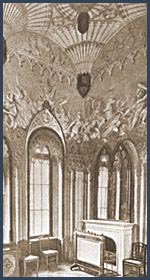 The White Tower is surrounded at each story by a balcony with cast iron balustrades and is open to the public in summer. It consists of a series of rooms, built one above the other, and decorated with frescoes in Gothic style, which are badly damaged. The furniture is of the same style, and was probably made from Menelas' sketches. The first story consists of a Dining Room and of a Service Room; the ceiling is carved, the walls are covered with frescoes, and the furniture is of ash. Here too are some paper screens, with pasted pictures of gentlemen and ladies' fashions, cut from journals of the epoch of about 1825. In the second story are two rooms for footmen; the walls are painted with a green wash; the furniture is made of birch. In the third story is a Drawing Room (seen at right) with four windows and one door which opens onto a balcony; the door and window posts are of light wood and richly carved; the ceilings are also carved, the walls have frescoes, representing a battle of the Middle Ages; there are two looking-glasses in carved frames, two mantlepieces of white marble with mirrors above them, likewise in rich frames; the furniture is of oak with cane seats.
The White Tower is surrounded at each story by a balcony with cast iron balustrades and is open to the public in summer. It consists of a series of rooms, built one above the other, and decorated with frescoes in Gothic style, which are badly damaged. The furniture is of the same style, and was probably made from Menelas' sketches. The first story consists of a Dining Room and of a Service Room; the ceiling is carved, the walls are covered with frescoes, and the furniture is of ash. Here too are some paper screens, with pasted pictures of gentlemen and ladies' fashions, cut from journals of the epoch of about 1825. In the second story are two rooms for footmen; the walls are painted with a green wash; the furniture is made of birch. In the third story is a Drawing Room (seen at right) with four windows and one door which opens onto a balcony; the door and window posts are of light wood and richly carved; the ceilings are also carved, the walls have frescoes, representing a battle of the Middle Ages; there are two looking-glasses in carved frames, two mantlepieces of white marble with mirrors above them, likewise in rich frames; the furniture is of oak with cane seats.
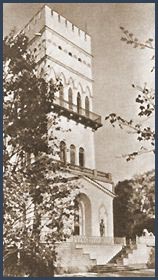 In the fourth story of the White Tower (seen at left), there are two rooms: the first is a Study, with a carved ceiling and frescoed walls, representing knights in Gothic armor; one door leads onto a balcony; the door and window frames are of carved oak; there are two mirrors and an ornamental cast-iron fire-grate; the furniture is of mahogany; in two corners stand huge pedestals of carved wood, each supporting a knight's bust. The second apartment is a Bedroom; the furniture is of maple in Empire style, ornamented in antique bronze moitifs, and consisting of a folding wooden bed, a divan, a sofa, two easy-chairs, a table, and a washing-stand. In both rooms, the chairs have cane seats. In the fifth story there is one room with nine, semi-oval windows; it contains a set of children's furniture upholstered in buckram; there are also two models of unknown buildings, toys, billiards for children, and the model of a waterfall, belonging to the Emperor Alexander II. The sixth story has a door, leading out onto the top of the tower. All the rooms and the tower communicate with each other by means of a, winding staircase; the door and window posts are of carved oak.
In the fourth story of the White Tower (seen at left), there are two rooms: the first is a Study, with a carved ceiling and frescoed walls, representing knights in Gothic armor; one door leads onto a balcony; the door and window frames are of carved oak; there are two mirrors and an ornamental cast-iron fire-grate; the furniture is of mahogany; in two corners stand huge pedestals of carved wood, each supporting a knight's bust. The second apartment is a Bedroom; the furniture is of maple in Empire style, ornamented in antique bronze moitifs, and consisting of a folding wooden bed, a divan, a sofa, two easy-chairs, a table, and a washing-stand. In both rooms, the chairs have cane seats. In the fifth story there is one room with nine, semi-oval windows; it contains a set of children's furniture upholstered in buckram; there are also two models of unknown buildings, toys, billiards for children, and the model of a waterfall, belonging to the Emperor Alexander II. The sixth story has a door, leading out onto the top of the tower. All the rooms and the tower communicate with each other by means of a, winding staircase; the door and window posts are of carved oak.
From the top of the tower opens a magnificent view on the neighbourhood of Tsarskoe Selo. There used to be here a semaphore telegraph; the signals from which were received on a similar wooden tower, still existing not far from the aerodrome in St. Petersburg. During the reign of the Empress Catherine, artillery, for firing salutes on solemn occasions, was kept on the bastion at the White Tower.







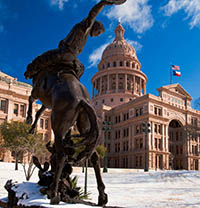




 Imperial Bedroom
Imperial Bedroom Portrait Hall
Portrait Hall Mauve Room
Mauve Room Maple Room
Maple Room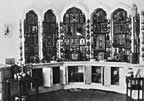 Aleksey's Bedroom
Aleksey's Bedroom Nicholas's Study
Nicholas's Study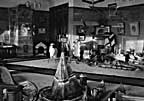 Aleksey's Playroom
Aleksey's Playroom Formal Reception
Formal Reception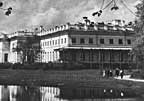 Balcony View
Balcony View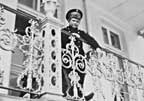 Aleksey- Balcony
Aleksey- Balcony Children-Mauve
Children-Mauve Nicholas's Bathroom
Nicholas's Bathroom Alexandra- Mauve
Alexandra- Mauve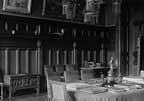 Nicholas's Reception
Nicholas's Reception Tsarskoe Selo Map
Tsarskoe Selo Map